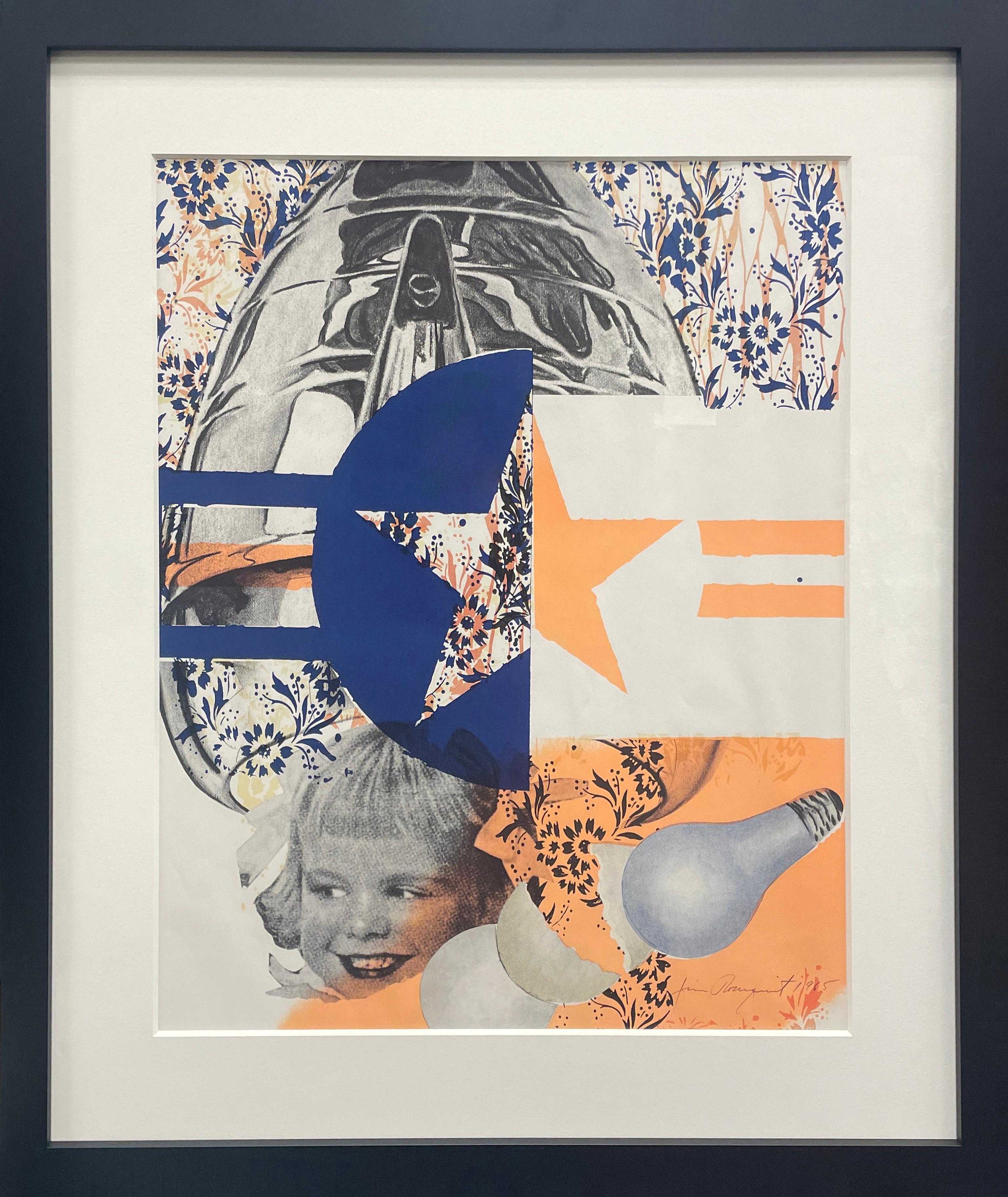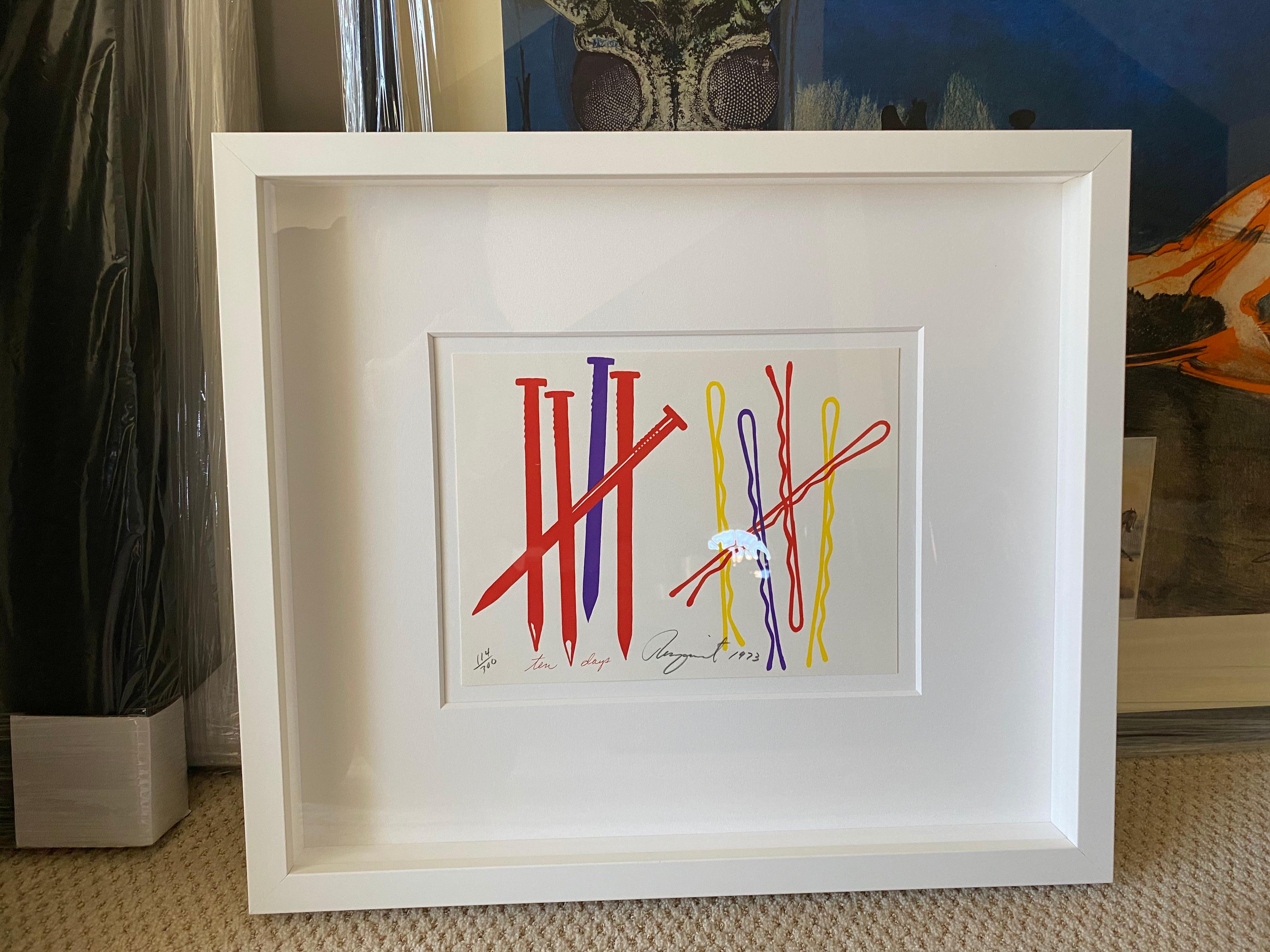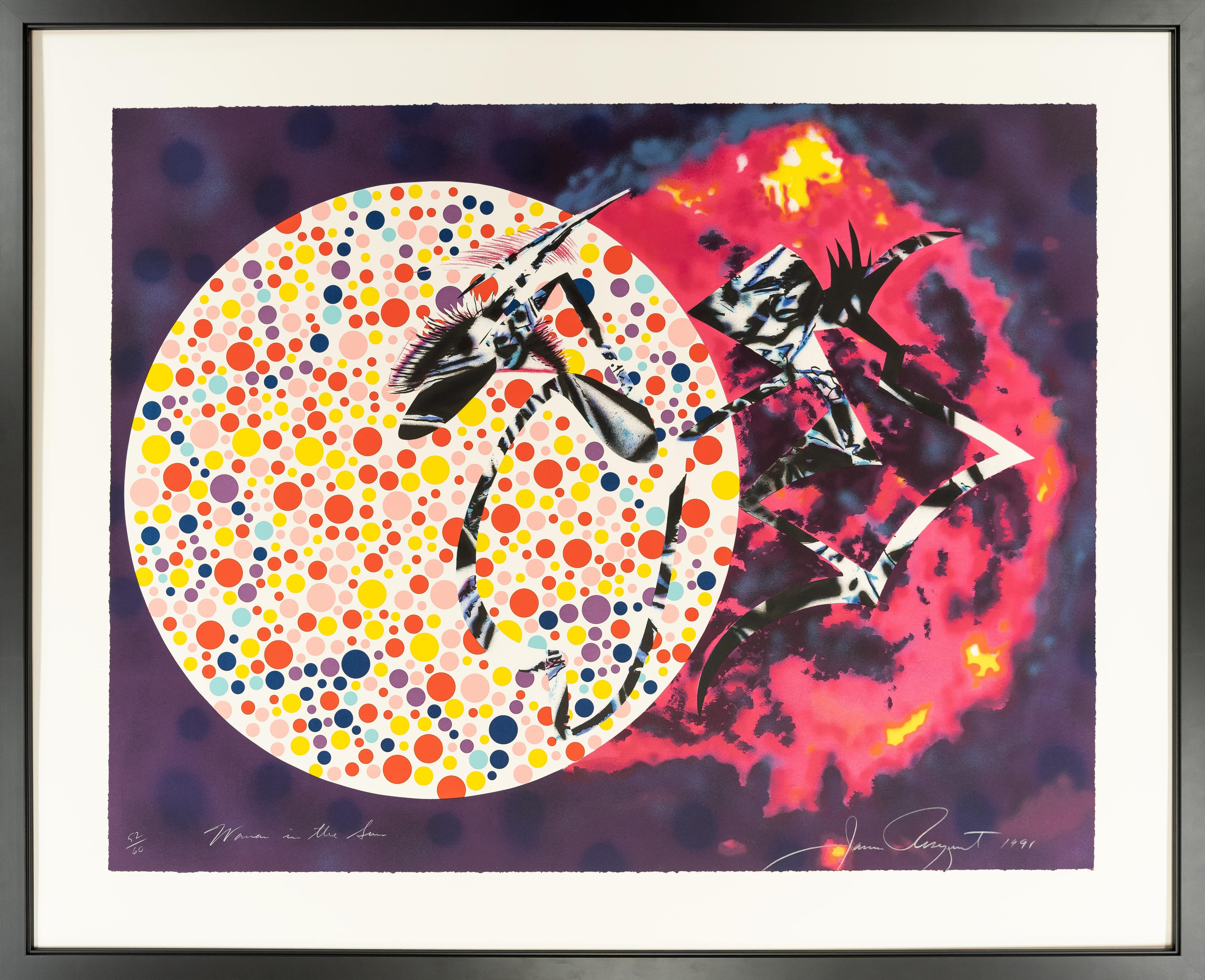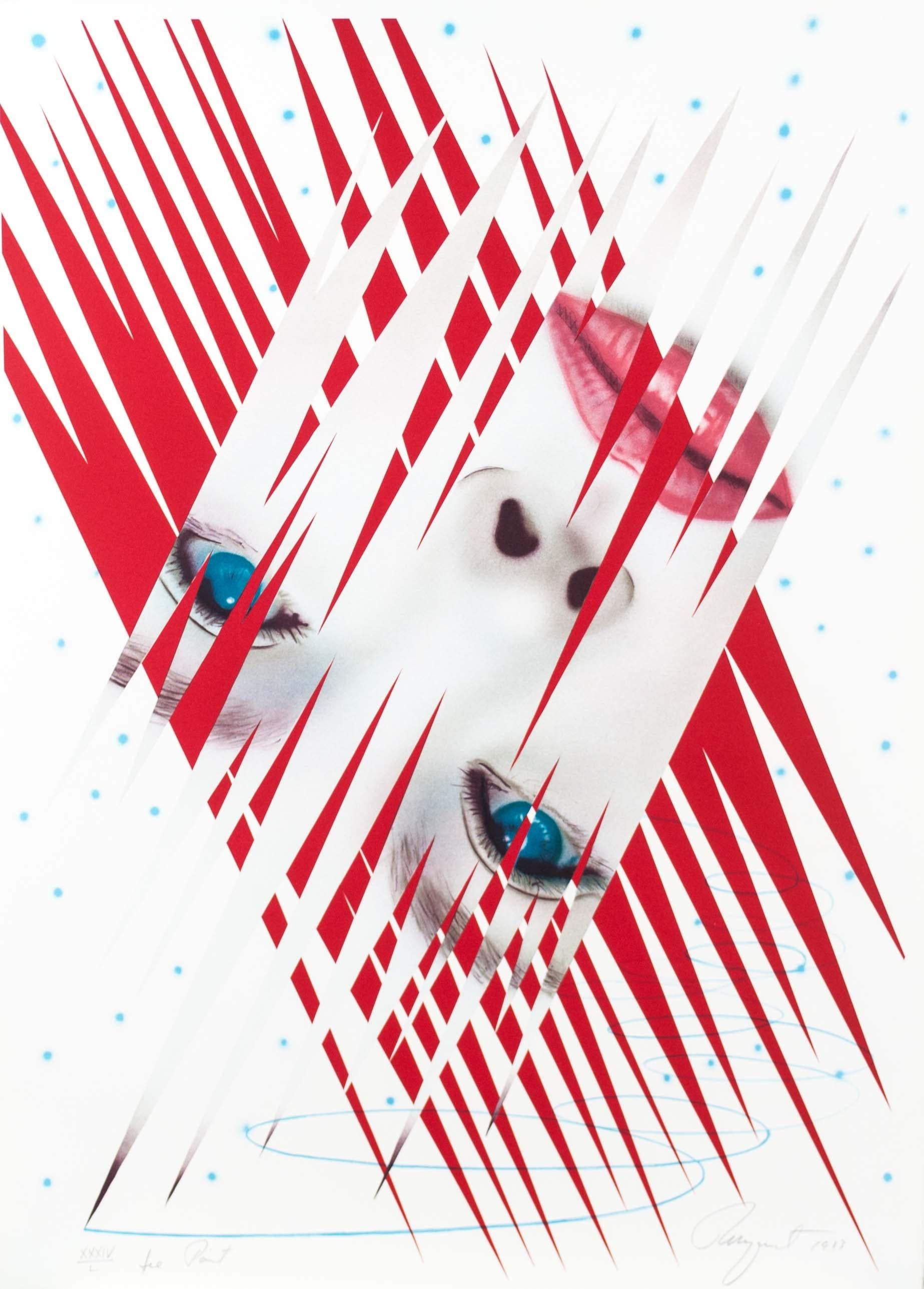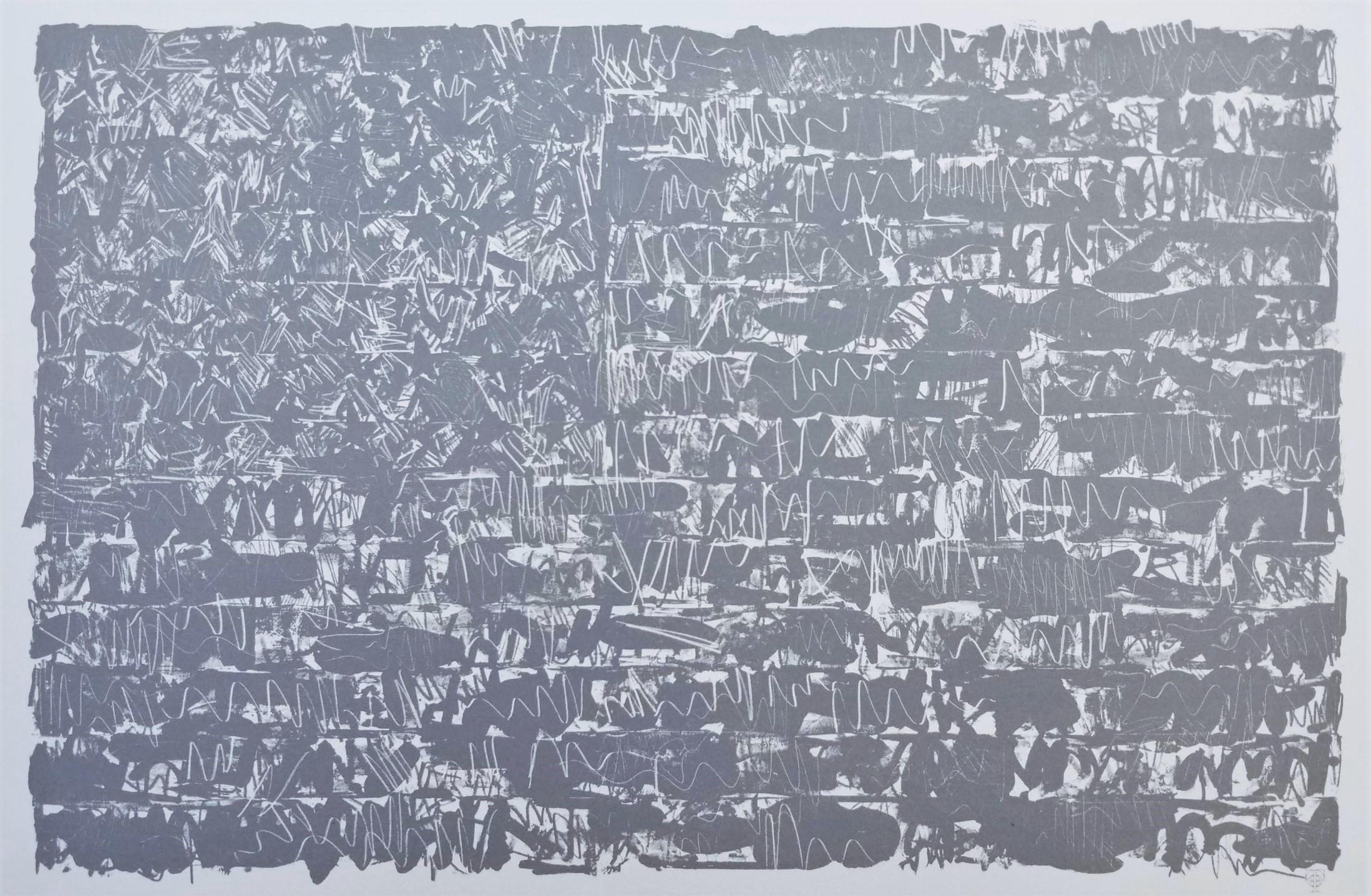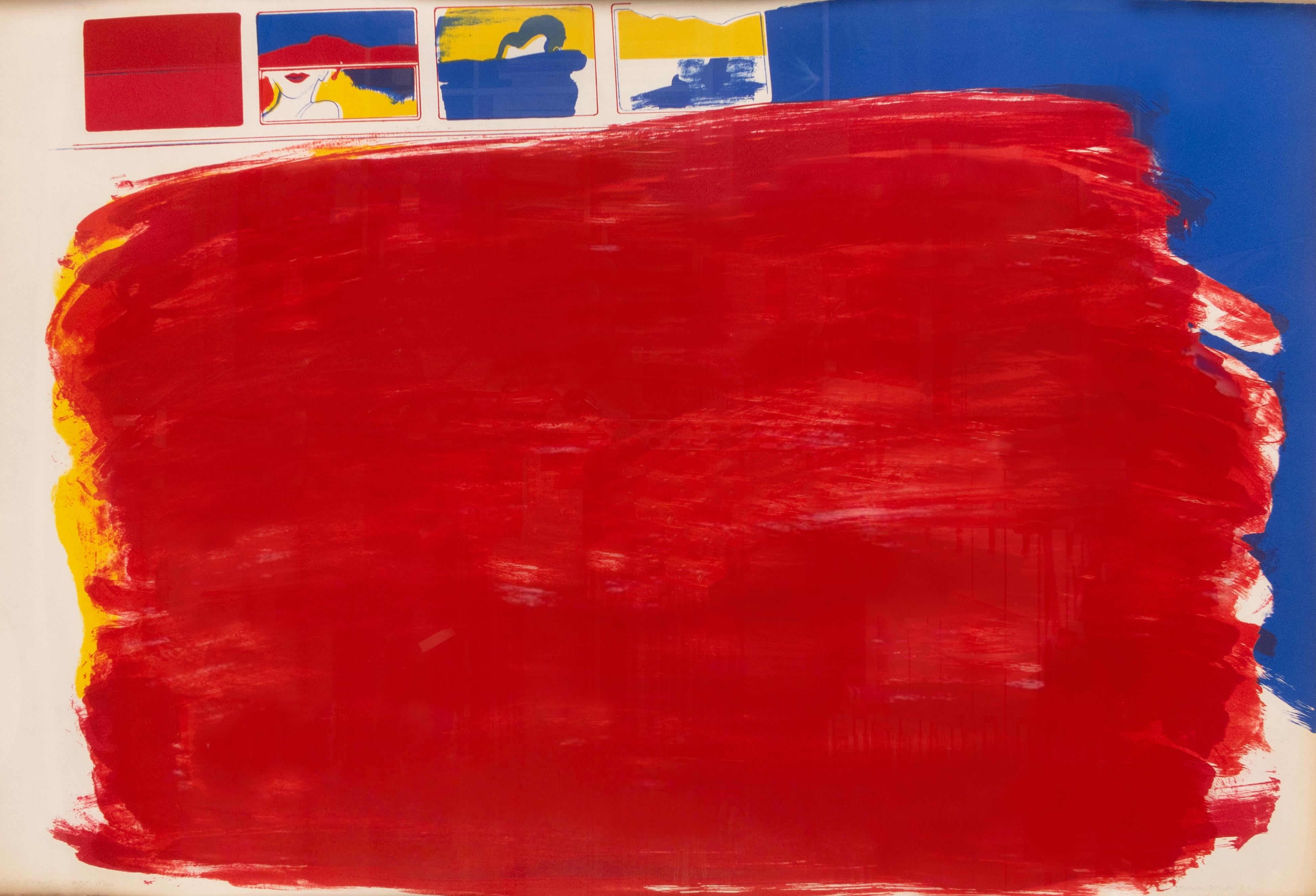Roy LichtensteinRoy Lichtenstein "Figures" 1978 (From Surrealist Series) Gemini G.E.L. Printers 1978
1978
About the Item
- Creator:Roy Lichtenstein (1923 - 1997, American)
- Creation Year:1978
- Dimensions:Height: 35 in (88.9 cm)Width: 26 in (66.04 cm)
- Medium:
- Movement & Style:
- Period:
- Condition:
- Gallery Location:Detroit, MI
- Reference Number:1stDibs: LU1286112744522
Roy Lichtenstein
Roy Lichtenstein is one of the principal figures of the American Pop art movement, along with Andy Warhol, James Rosenquist, Claes Oldenburg and Robert Rauschenberg.
Drawing inspiration from comic strips, Lichtenstein appropriated techniques commercial printing in his paintings, introducing a vernacular sensibility to the visual landscape of contemporary art. He employed visual elements such as the halftone dots that comprise a printed image, and a comic-inspired use of primary colors gave his paintings their signature “Pop” palette.
Born and raised in New York City, Lichtenstein enjoyed Manhattan’s myriad cultural offerings and comic books in equal measure. He began painting seriously as a teenager, studying watercolor painting at the Parsons School of Design in the late 1930s, and later at the Art Students League, where he worked with American realist painter Reginald Marsh. He began his undergraduate education at Ohio State University in 1940, and after a three-year stint in the United States Army during World War II, he completed his bachelor’s degree and then his master’s in fine arts. The roots of Lichtenstein’s interest in the convergence of high art and popular culture are evident even in his early years in Cleveland, where in the late 1940s, he taught at Ohio State, designed window displays for a department store and painted his own pieces.
Working at the height of the Abstract Expressionist movement in the 1950s, Lichtenstein deliberately eschewed the sort of painting that was held in high esteem by the art world and chose instead to explore the visual world of print advertising and comics. This gesture of recontextualizing a lowbrow image by importing it into a fine-art context would become a trademark of Lichtenstein’s artistic style, as well as a vehicle for his critique of the concept of good taste. His 1963 painting Whaam! confronts the viewer with an impact scene from a 1962-era issue of DC Comics’ All American Men of War. Isolated from its larger context, this image combines the playful lettering and brightly colored illustration of the original comic with a darker message about military conflict at the height of the Cold War. Crying Girl from the same year featured another of Lichtenstein’s motifs — a woman in distress, depicted with a mixture of drama and deadpan humor. His work gained a wider audience by creating a comic-inspired mural for the New York State Pavilion of the 1964 World's Fair, he went on to be represented by legendary New York gallerist Leo Castelli for 30 years.
In the 1970s and ’80s, Lichtenstein experimented with abstraction and began exploring basic elements of painting, as in this 1989 work Brushstroke Contest. In addition to paintings in which the brushstroke itself became the central subject, in 1984 he created a large-scale sculpture called Brushstrokes in Flight for the Port Columbus International Airport in Ohio. Still Life with Windmill from 1974 and the triptych Cow Going Abstract from 1982 both demonstrate a break from his earlier works where the subjects were derived from existing imagery. Here, Lichtenstein paints subjects more in line with the norms of art history — a pastoral scene and a still life — but he has translated their compositions into his signature graphic style, in which visual elements of printed comics are still a defining feature.
Lichtenstein’s work is represented in the collections of the Metropolitan Museum of Art, the Museum of Modern Art, Tate Modern, and many others. He was awarded National Medal of Arts in 1995, two years before he passed away.
Find a collection of Roy Lichtenstein prints, drawings and more on 1stDibs.
- ShippingRetrieving quote...Ships From: Detroit, MI
- Return PolicyA return for this item may be initiated within 14 days of delivery.
- Douglas Semivan Abstract Modern "Receiver I" Signed and NumberedBy Douglas SemivanLocated in Detroit, MISALE ONE WEEK ONLY "Receiver I" is an abstract print of three diagonally placed lines. It is reminiscent of an early work by Georgia O'Keeffe, "Blue Lines X" in that both artists, Semivan and O'Keeffe, have achieved a beauty in the placement, width of, length and juxtapositions of simple lines to achieve a never ending balance and harmony for the viewer. Born in Detroit, Michigan, Douglas Semivan...Category
Late 20th Century American Modern Abstract Prints
MaterialsPaper, Lithograph
- Robert Natkin Abstract Lithograph Signed NumberedBy Robert NatkinLocated in Detroit, MISALE ONE WEEK ONLY Soft pastel colors in floating smudges lay between and around lyrical abstract geometric and organic forms giving a diaphanous color and shape harmony to the work...Category
1990s Abstract Expressionist Abstract Prints
MaterialsLithograph
- "Travelers", Abstract Drypoint Etching and Aquatint, Numbered and SignedBy Richard JacobsLocated in Detroit, MI"Travelers" is a work that displays Richard Jacobs early Balinese influence. This abstract work made with drypoint etching manifests a layer of depth and contrast that is achieved through an Indonesian technique of drawing the lines of the resist or printing it with a copper stamp that allows an artisan to selectively color the work through the soaking process. "Travelers" is exemplary of this earlier aquatint process before Jacobs would go on to apply a diversity of colors to his work. The print is 39 x 29 inches and is signed and numbered from an edition of 30 by the artist. Numbered edition may not necessarily be number 16 as there are multiple prints in the possession of Collected Detroit...Category
1990s Abstract Prints
MaterialsEtching, Aquatint, Lithograph, Drypoint
- "Holiday", Abstract Drypoint Etching and Aquatint, Numbered and SignedBy Richard JacobsLocated in Detroit, MI"Holiday" is a work that displays Richard Jacobs early Balinese influence. This abstract work made with drypoint etching manifests a layer of depth and contrast that is achieved through an Indonesian technique of drawing the lines of the resist or printing it with a copper stamp that allows an artisan to selectively color the work through the soaking process. "Holiday" is exemplary of this earlier aquatint process before Jacobs would go on to apply a diversity of colors to his work. The print is 39 x 29 inches and is signed and numbered from an edition of 30 by the artist. Numbered edition may not necessarily be number 17 as there are multiple prints in the possession of Collected Detroit...Category
1990s Abstract Prints
MaterialsDrypoint, Etching, Aquatint, Lithograph
- Piero Dorazio Lithograph Abstract Geometric Quadrilateral PolygonBy Piero DorazioLocated in Detroit, MIThe work is a Lithograph, not numbered, but signed and dated by the artist, Piero Dorazio. The print has an intense color field with a strong linear element being composed of quadril...Category
1970s Abstract Expressionist Abstract Prints
MaterialsLithograph
- Arnold Singer "Woman on Arm of Sofa" Lithograph Linear Black & WhiteLocated in Detroit, MI“Woman on Arm of Sofa” is an extraordinary lithograph by Arnold Singer. You could say it is representative of his interests in several art styles that ar...Category
1960s Contemporary Figurative Prints
MaterialsLithograph
- F-111 (Castelli Gallery Poster)By James RosenquistLocated in Hinsdale, ILROSENQUIST, JAMES (1933 - 2017) F-111 (Castelli Gallery Poster) Offset Lithograph c. 1965 Signed and dated in pencil along lower edge Sheet Size: 28” x 22”, Fresh ...Category
1960s Pop Art Abstract Prints
MaterialsLithograph, Offset
- "Ten Days" limited edition lithograph by James RosenquistBy James RosenquistLocated in Hinsdale, ILJAMES ROSENQUIST "Ten Days, from The New York Collection for Stockholm" Lithograph in colors on paper,1973 9 x 12 inches (22.9 x 30.5 cm) (sheet) Ed. 114/300 Signed, numbered, and d...Category
1970s Pop Art Abstract Prints
MaterialsLithograph
- "Woman in the Sun" by James Rosenquist, 1991By James RosenquistLocated in Hinsdale, ILJAMES ROSENQUIST (B. 1933) "Woman in the Sun" 15 color lithograph from aluminum plate on mould-made paper, white Rives BFK, 1991 Catalog #225 She...Category
1990s Pop Art Abstract Prints
MaterialsLithograph
- Ice PointBy James RosenquistLocated in Ljubljana, SIIce Point. Original color lithograph, 1983. Edition of 150 signed and numbered impressions on Arches paper. Art and Sport portfolio: The Yugoslav Olympic Committee of the Winter Olympic Games Sarajevo...Category
1980s Pop Art Abstract Prints
MaterialsLithograph
- Flag III /// Pop Art Jasper Johns Abstract Lithograph America Minimalism ULAEBy Jasper JohnsLocated in Saint Augustine, FLArtist: (after) Jasper Johns (American, 1930-) Title: "Flag III" Series: Facsimile Catalogue of Jasper Johns Prints *Issued unsigned Year: 1975 Med...Category
1970s Pop Art Abstract Prints
MaterialsLithograph, Offset
- Large Bus by Allen Jones classic British 1960s pop art in bright primary colorsBy Allen JonesLocated in New York, NYThis large Allen Jones lithograph is printed exuberantly in primary colors. A swath of bright red brushstrokes represents the side of a bus. In the upper left, small windows reveal the passengers: a woman’s face is cut off above her vampy red lips, and a blue-haired man’s face is hidden. Royal blue fills the upper right corner of the composition, giving the impression of looking up at a passing bus against the cloudless sky. One can imagine Jones was thinking of the iconic red double decker bus the AEC Routemaster, first introduced in London in 1954. In the 1960s buses were a living symbol of familiar and new technology coexisting: as David Bucken put it, “In and around London a midpoint change on a journey might involve alighting from an RT bus, of which production had started just prior to World War II, and getting on one of the sexy new Routemasters.” In the artist’s words: “The whole problem as a figurative artist was that it was going against the main march of modernism, which was towards abstraction. But here was a way of making the subject you were painting the same as the object you were painting on. By making the canvas a rhomboid, and putting little wheels on it, you have a schematic version of a vehicle, in this case a London bus.” Jones plays with the space between abstraction and figuration: windowed passengers, elaborated with just a few lines and placed adjacent to a weighty red ground of brushstrokes, easily convey the form of a bus, yet the print also conveys Jones’ visceral, painterly delight in color play. Four color lithograph on wove paper Paper 28.5 x 42.5 / 72.4 X 108 cm Wood frame 31 x 46 x 2 in. / 78.75 x 117 x 5 cm with 1 in. moulding Signed by the artist lower right in pencil, labeled Trial Proof lower left in pencil. Edition 20. Printed at Tamarind Los Angeles with Clifford Smith...Category
1960s Pop Art Abstract Prints
MaterialsLithograph
